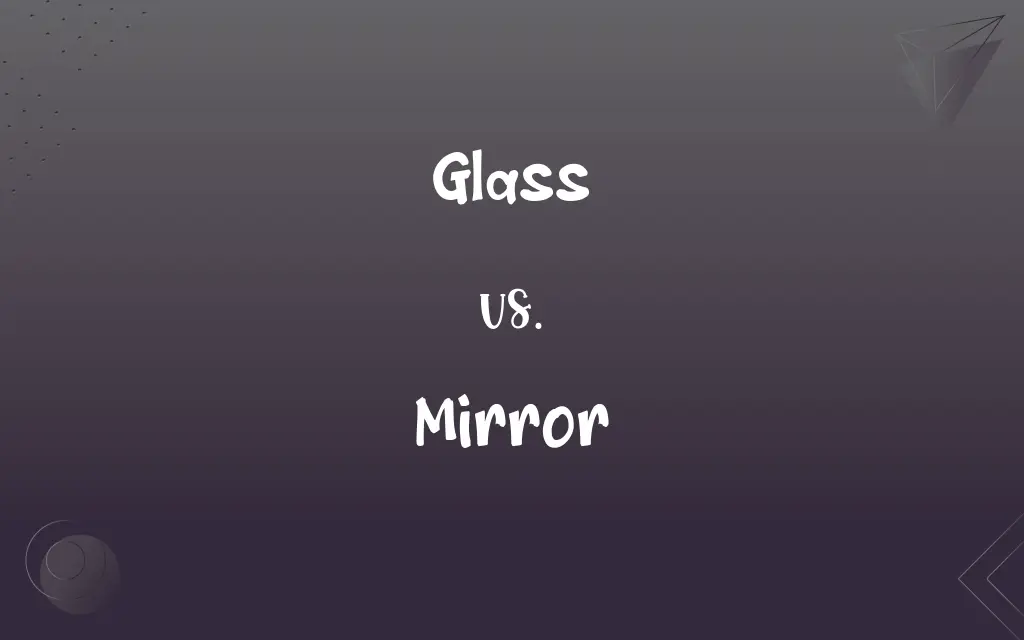Glass vs. Mirror: What's the Difference?
Edited by Aimie Carlson || By Harlon Moss || Published on January 17, 2024
Glass is a transparent, hard material made from silica, used in windows and containers; a mirror is a reflective glass surface, coated to produce images.

Key Differences
Glass is a versatile material, primarily made from silica, often used for its transparency in windows, bottles, and eyewear. Mirrors, on the other hand, are a specific application of glass, where one side is coated with a reflective material like silver or aluminum, making them essential for reflecting images in daily life, from grooming to interior decoration.
The main purpose of glass in various forms is to either allow light to pass through, as in windows, or to contain objects, like in glassware. Mirrors, however, serve a different purpose; they are designed to reflect light and images, providing a visual representation of objects placed before them. This reflective capability sets mirrors apart from standard glass.
In terms of manufacturing, glass can be shaped and finished in various ways – clear, tinted, tempered, or laminated. Mirrors require an additional step: the application of a reflective coating, which is a crucial process that transforms ordinary glass into a mirror, capable of reflection.
When it comes to applications, glass is seen in architecture, vehicles, containers, and various household items. Mirrors, however, are primarily used in bathrooms, bedrooms, vehicles (as rearview mirrors), and in art and decoration, highlighting their distinct functional and aesthetic roles.
The interaction with light differs; glass primarily allows light to pass through or is used to diffuse it, whereas mirrors are specifically designed to reflect light, creating an image that is a vital part of their functionality.
ADVERTISEMENT
Comparison Chart
Composition
Made from silica, with variations like soda-lime
Glass with a reflective coating (like silver)
Primary Function
Allows light to pass through or contain objects
Reflects light and images
Manufacturing
Can be clear, tinted, or tempered
Requires a reflective coating process
Usage
Used in windows, containers, eyewear
Used for reflection in grooming, decoration
Interaction with Light
Transmits or diffuses light
Reflects light
ADVERTISEMENT
Glass and Mirror Definitions
Glass
Glass is a material used in making windows, bottles, and eyeglasses.
Her new eyeglasses had thin, lightweight glass lenses.
Mirror
A mirror is a reflective surface, usually made of glass, that forms images.
She looked in the mirror to check her makeup.
Glass
Glass refers to a brittle, transparent substance used in everyday objects.
He drank water from a tall glass.
Mirror
Mirror refers to a glass surface coated with a metal amalgam for reflection.
The antique mirror had an ornate frame.
Glass
Glass is a see-through material commonly used in building and manufacturing.
The greenhouse was made entirely of glass to let in maximum sunlight.
Mirror
A mirror is used for personal grooming, decoration, and architectural elements.
The dance studio was lined with large wall mirrors.
Glass
Glass, in its various forms, is used for both functional and decorative purposes.
The artist created a beautiful sculpture entirely out of colored glass.
Mirror
A mirror is a polished surface for reflecting light and images.
The mirror in the hallway reflected the bright sunlight.
Glass
Glass is a hard, transparent material made from silica.
The glass windows in the building offered a clear view of the city.
Mirror
Mirror describes a reflective glass used in vehicles and instruments.
He adjusted the rearview mirror to get a better view.
Glass
Any of a large class of materials with highly variable mechanical and optical properties that solidify from the molten state without crystallization, are typically made by silicates fusing with boric oxide, aluminum oxide, or phosphorus pentoxide, are generally hard, brittle, and transparent or translucent, and are considered to be supercooled liquids rather than true solids.
Mirror
A surface capable of reflecting sufficient undiffused light to form an image of an object placed in front of it. Also called looking glass.
Mirror
Something that faithfully reflects or gives a true picture of something else.
FAQs
What is glass made of?
Glass is primarily made from silica, often combined with soda-lime and other materials.
Are mirrors only made from glass?
While most mirrors are glass-based, they can also be made from metals and other reflective materials.
What is frosted glass?
Frosted glass is etched or coated for a translucent finish that obscures visibility.
Can mirrors be used for security?
Yes, mirrors are used in security applications for visibility and surveillance.
How is a mirror different from regular glass?
A mirror is glass coated with a reflective material like silver or aluminum to reflect images.
Can glass be colored?
Yes, glass can be tinted or colored during its manufacturing process.
What is tempered glass?
Tempered glass is heat-treated for increased strength and safety.
Are there different types of mirrors?
Yes, mirrors come in various types, like plane, concave, and convex mirrors.
Is mirror glass recyclable?
Mirror glass is harder to recycle than regular glass due to its reflective coating.
How is stained glass different?
Stained glass is colored and often used in artistic and decorative contexts.
How is glass recycled?
Glass is crushed, cleaned, and melted to form new glass products.
What's a smart mirror?
A smart mirror combines a reflective surface with digital technology, like displays and sensors.
Is lead glass safe?
Lead glass can be hazardous and is less common now due to health concerns.
Are antique mirrors valuable?
Antique mirrors can be valuable, especially if they are rare or historically significant.
Can glass be bulletproof?
Yes, special multilayered glass can be made bulletproof for security purposes.
What is a one-way mirror?
A one-way mirror allows viewing from one side while appearing reflective on the other.
Do mirrors have a standard thickness?
Mirrors vary in thickness, often depending on their size and application.
What is laminated glass?
Laminated glass consists of layers bonded together for safety and durability.
Is glass naturally occurring?
While most glass is man-made, natural glass, like obsidian, exists.
Can mirrors enhance room lighting?
Yes, strategically placed mirrors can reflect and amplify light in a room.
About Author
Written by
Harlon MossHarlon is a seasoned quality moderator and accomplished content writer for Difference Wiki. An alumnus of the prestigious University of California, he earned his degree in Computer Science. Leveraging his academic background, Harlon brings a meticulous and informed perspective to his work, ensuring content accuracy and excellence.
Edited by
Aimie CarlsonAimie Carlson, holding a master's degree in English literature, is a fervent English language enthusiast. She lends her writing talents to Difference Wiki, a prominent website that specializes in comparisons, offering readers insightful analyses that both captivate and inform.







































































